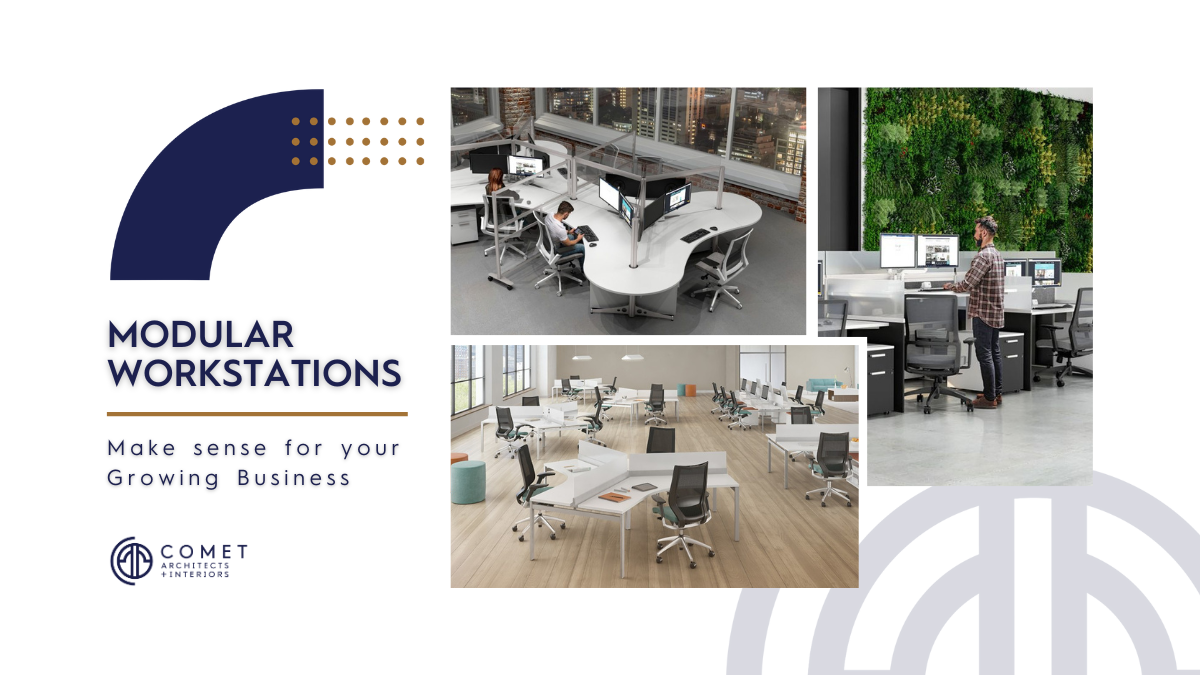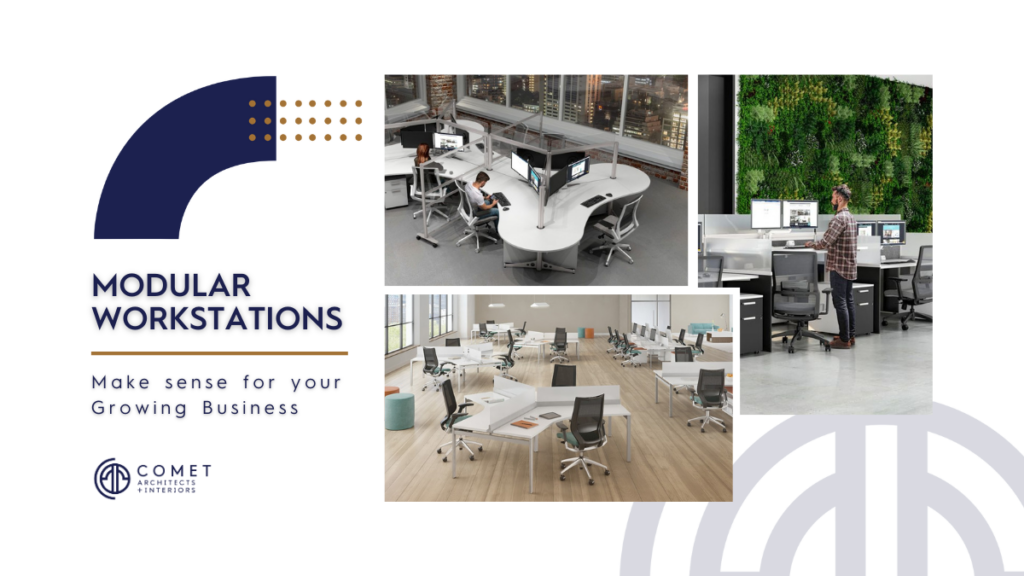
Modular Workstations Make Sense For Your Growing Business

Growing your business in our hybrid reality means responding quickly to employee and client needs you may not have considered before the pandemic: flex spaces, improved breakrooms, more collaboration spaces, and a greater emphasis on employee wellbeing. Fortunately, it has never been easier to get creative with office furniture solutions for workplace design adaptability.
“Modular furniture allows you to combine various components, such as desks and filing systems, to create a variety of workstation layouts.”
What should you do first? We recommend focusing on what is most important—the employee environment. Work and productivity suffer when your team is uneasy. Spend the time and money to create a healthy modern office system that works for you and them, and you’ll see how the benefits affect the bottom line.
Let’s Talk Modular
It’s time to consider modular office furniture that’s simple to adjust. Modular furniture allows you to combine various components, such as desks and filing systems, to create a variety of workstation layouts. This adaptability allows you to respond to changes in the number of people in the office. Workstations also work well for desk hoteling or hotdesking if your organization has implemented these in the hybrid office.
Here are some things to think about when choosing a modular furniture layout for your office.
Flexibility in Design
Look for a modular office workstation system that can be reconfigured into a variety of pod layouts. This allows for activity-based work while maintaining a consistent aesthetic throughout the space.
Don’t forget about individual needs when outfitting your workstations. Monitor arms and keyboard trays, for example, adapt to different body shapes and sizes for maximum comfort and productivity in your modular office workstations.
Types of Workstations
- Curved
Curved workstations defy the stereotype of the “square cube” and add a brilliantly fresh look and feel to any modern office. They not only make sense for a busy office by reducing sharp corners and providing closer body-to-keyboard comfort, but they also provide more enclosed privacy when properly arranged.
- Sit-to-Stand
Extensive periods of stationary sitting at traditional desks have been identified as potential contributors to a range of health issues, as indicated by research findings. Despite this growing awareness, a rather unexpected trend persists within numerous commercial workplaces – sit-to-stand desks, designed to alleviate these concerns, are often reserved exclusively for executives or granted on a limited basis to employees who specifically request them. However, a paradigm shift is essential, recognizing that the advantages of such desks should extend far beyond a select few, and that configuring workstations in alignment with healthy practices is paramount for the overall well-being and productivity of the entire workforce.
The concept of sit-to-stand desks goes beyond a mere design innovation; it is a proactive approach towards safeguarding and enhancing employee health. These desks serve as dynamic solutions, facilitating a seamless transition between sitting and standing positions. By allowing individuals to alternate between these postures, the potential negative impacts of prolonged sitting, such as musculoskeletal discomfort and reduced circulation, can be mitigated. The act of standing during work encourages micro-movements, activating muscles and promoting blood flow, which not only fosters physical well-being but also contributes to mental alertness and vitality.
- Managerial Collaborative Modular Workstations
The introduction of a managerial collaborative workstation represents a strategic enhancement in fostering effective communication and facilitating seamless transitions within a managerial context. This innovative layout serves as a conduit for improved interactions among managers, while also streamlining the integration of new employees into the organizational fabric. With its versatile design, this workspace configuration emerges as an invaluable asset, particularly for pairs of coworkers engaged in consistent collaboration, offering a harmonious alternative to the conventional approach of hovering within cubicles or exchanging constant digital notifications on platforms like Slack.
“Encourage innovation among employees by providing the space they need to explore and solve creative problems.”
This layout is also useful for quickly orienting new employees to the company culture. Assign them a workstation with a “mentor” or senior employee, or another new hire, so they can get started right away.
- Minimalist
Embracing the concept of a minimalist workstation heralds a strategic approach that harmonizes seamlessly with the evolving landscape of hybrid work arrangements. Particularly suited for employees who divide their time between the office and remote locations, this streamlined design encapsulates both functionality and efficiency. By facilitating easy ingress and egress, and complementing the setup with personalized storage solutions, this workstation design empowers workers to navigate their work environment effortlessly and enhances the fluidity of their hybrid workstyle.
Central to the minimalist workstation’s effectiveness is its capacity to adapt to the dynamic needs of modern employees. With personal storage cabinets or locked filing systems thoughtfully integrated into the layout, employees can effortlessly transition between workspaces. This feature not only ensures a smooth flow of work materials and equipment but also provides a sense of ownership and familiarity, no matter where they choose to set up. This adaptability echoes the modern workforce’s demand for flexibility and the freedom to seamlessly move between office and remote work settings.
- Extended Work Surface Workstations
Research suggests that a cluttered desk, seemingly chaotic, possesses an unexpected allure – it nurtures creativity. This intriguing insight lays the foundation for a novel approach to encouraging employee innovation: granting them a spatial canvas to explore and unravel creative conundrums. Embracing this notion, businesses can propel their teams towards innovative breakthroughs by providing the breathing room required to think, ideate, and solve problems in an environment that doesn’t stifle the organic flow of inspiration.
The importance of affording ample space for creative endeavors cannot be overstated. In this context, a larger work surface becomes a catalyst for unbridled creativity. Such expansiveness accommodates not only the tangibles of creative expression but also the intangibles – the mental expanse required for deep thinking and immersive brainstorming. This generous expanse invites employees to spread out their thoughts, materials, and prototypes, fostering an unencumbered exploration of ideas. Additionally, the larger surface area proves invaluable for impromptu meetings, sidestepping the logistical complexities of reserving formal conference rooms or navigating a first-come, first-served approach to collaborative spaces.
As the discourse surrounding the permanence of the hybrid office model continues to reverberate, the merits of modular workstations stand resolute and compelling. These dynamic and adaptable setups offer an array of benefits that can seamlessly align with the evolving needs of businesses. The flexibility inherent in modular workstations is a testament to their effectiveness in accommodating shifting work dynamics and spatial requirements. These stations can evolve in tandem with a company’s growth trajectory, expanding and contracting as necessary, thus serving as a tangible embodiment of a business’s agility and resilience.
Comet will lend a hand to you in achieving this; contact us now to find out more.

